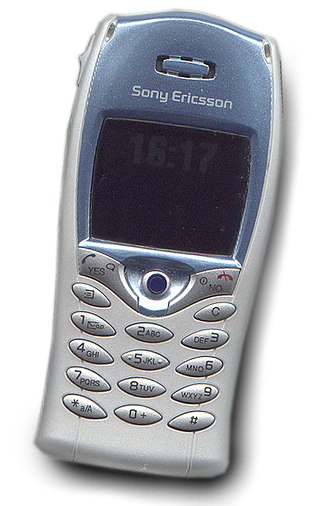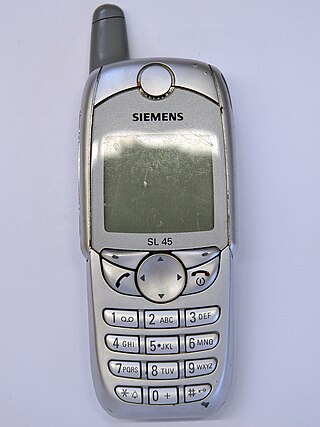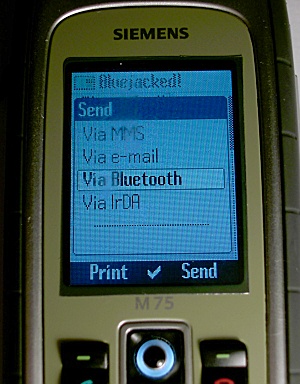
The Nokia 6230 is a mobile phone based on the Nokia Series 40 platform. It was announced on 28 October 2003 and released in February 2004.

The Ericsson T68m was a candy-bar style mobile phone by Ericsson Mobile Communications. Launched in time for the 2001 Christmas season, the T68 was the first Ericsson mobile phone to have a colour screen, a passive LCD-STN with a resolution of 101×80 and 256 colours. Despite its diminute size, it was one of the most feature-rich mobile phones at the time, with Bluetooth, IrDA port, GPRS 3+1, tri-band compatibility, SMS with T9, EMS, WAP, and customizable monophonic ring tones. A simple bitmap image editor was provided, allowing the creation of monochrome pictures by guiding a cursor around the canvas and setting or unsetting individual pixels. These images could be set as the phone's background image in standby mode, and sent to owners of EMS-compliant phones. With EMS soon to be succeeded by the superior MMS, few owners made much use of this feature. At its release, the phone cost around € 500, GBP299 in the UK, in either two-tone grey or all-gold.

Siemens Mobile was a German mobile phone manufacturer and a division of Siemens AG. Siemens sold Siemens Mobile to the Taiwan-based BenQ in 2005, subsequently becoming BenQ-Siemens and succeeded by Gigaset. The last Siemens-branded mobile phones, the AL21, A31 and AF51, were released in November 2005.

The Siemens SL45 was the first mobile phone with memory expansion and an MP3 player, which debuted in late 2000. An improved version, the SL45i, was also the first phone to have a Java virtual machine.
The Siemens SX45 is a PDA mobile phone released by Siemens in 2002. It was one of the first Pocket PCs with mobile phone functionality. Because of its size and the fact that phone calls could only be made using a headset, it was not really in the same marketing segment as current smartphones.
The O2 Xda brand was a range of Windows Mobile PDA phones, marketed by O2, developed by O2 Asia and manufactured by multiple OEMs (mainly HTC, Quanta and Arima). The first model was released in June 2002. The last models came to market in 2008. The "X" represents convergence of voice and information/data within one product; the "DA" stands for "Digital Assistant", as in PDA. The name of XDA Developers is derived from it.

The Nokia 3230 is a Symbian Series 60 mobile phone announced on November 2, 2004. It was billed as the first Series 60 phone aimed at the mass-market rather than the higher-end Series 60 devices with a relatively low cost of 350 euros when released in Q1 2005. This phone was designed as a replacement for two previous youth-oriented Nokia phones - the Nokia 3660 Series 60 smartphone and the Nokia 3220 feature phone. No variant of this phone was released for the United States market.

The Siemens M75, this is the successor of Siemens M65. The phone released in 2005, is manufactured by BenQ Mobile. It is one of the few mobile phones to be weather and shock resistant, while not skimping on other features like a 1.3MP digital camera, 262k color screen and a digital music player supporting the MP3 and AAC formats. It comes in 2 color variants, safari green and black.

The Samsung SGH-D600 is a GSM mobile phone released in the first quarter of 2005 made by Samsung Electronics.

Android 13 is the thirteenth major release and the 20th version of Android, the mobile operating system developed by the Open Handset Alliance led by Google. It was released to the public and the Android Open Source Project (AOSP) on August 15, 2022. The first devices to ship with Android 13 were the Pixel 7 and 7 Pro.

W710 is a mobile phone produced by Sony Ericsson.

The Siemens CX75 was released in 2005, and is a mobile phone manufactured by BenQ Mobile.

The Sony Ericsson K810i Cyber-shot is a dual-mode UMTS phone with a 3.2 Megapixel camera with autofocus and 16x digital zoom. It has the full range of mobile entertainment and business features including video telephony, Memory Stick Micro removable storage, picture blogging, full HTML browser, RSS feed support, and music and video players. It is a later iteration of the Sony Ericsson K800i, and both phones have since been succeeded by the Sony Ericsson K850i.

The MB-910 is a tri-band/GPRS watch phone made by Hyundai Mobile Europe in Leitz Austria Vertriebs GmbH.

The Sony Ericsson T707 is a fashion-oriented mobile phone from Sony Ericsson. It was announced on 26 March 2009, in conjunction with tennis star Maria Sharapova. The product was discontinued in January 2012.

The Samsung Omnia II GT-I8000(H/L/U) is a multimedia smartphone announced at Samsung Mobile Unpacked on June 15, 2009. Earlier Omnia II releases run Windows Mobile 6.1, however they are upgradable to version 6.5 Professional. There is also an unofficial and experimental Android version available. Verizon is the official US carrier for this phone and released it in December 2009.

The WIMM One is a developer device for the WIMM platform produced by WIMM Labs. It is a wearable computing device running a modified version of the Android operating system. It comes preloaded with several apps. Additional applications can be downloaded from the micro app store or side-loaded over USB.

Nexus 6P is an Android smartphone developed and marketed by Google and manufactured by Huawei. It succeeded the Nexus 6 as the flagship device of the Nexus line of Android devices by Google. Officially unveiled on 29 September 2015 along with the Nexus 5X at the Google Nexus 2015 press event held in San Francisco, it was made available for pre-order on the same day in United States, United Kingdom, Ireland, and Japan.
The Pixel and Pixel XL are a pair of Android smartphones designed, developed, and marketed by Google as part of the Google Pixel product line, succeeding the Nexus line of smartphones. They were officially announced on October 4, 2016 at the Made by Google event and released in the United States on October 20. On October 4, 2017, they were succeeded by the Pixel 2 and Pixel 2 XL.
The Pixel 2 and Pixel 2 XL are a pair of Android smartphones designed, developed, and marketed by Google as part of the Google Pixel product line. They collectively serve as the successors to the Pixel and Pixel XL. They were officially announced on October 4, 2017 at the Made by Google event and released in the United States on October 19. On October 9, 2018, they were succeeded by the Pixel 3 and Pixel 3 XL.

















